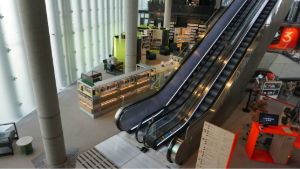By Angie Fryer
This is the first of a four-part series about Amelia Earhart. Click through to read part two, three, and four.

The first time I heard about Amelia Earhart was in the fourth grade. I’d been on a rampage reading every biography of a famous woman I could find in the library. Amelia Earhart: Kansas Girl was next up on the list, and little did I know that someone exciting and mysterious was about to enter my world. Someone that would tease and taunt all of us about her final flight for nearly a century.
When I recently began to research this piece, I was nervous: afraid I’d dig up something terrible about her that would ruin my hero worship. We don’t need to look too far in the rearview mirror to see things that have not aged well. Amelia was born in Kansas in 1897. Most people were still travelling by horse then, so I purposefully set my expectations low.
I asked a 20-something woman I work with, “what do you know about Amelia Earhart?” She thought for a minute and asked, “Was she the first woman to fly a plane? And something about her being eaten by crabs?”
Clearly, my work is cut out for me. As to the crabs, nobody knows. Every few years, another hopeful expedition uncovers something via satellite imagery, or a submersible drone, or local divers in the Marshall Islands. Most recently, a pile of rocks that (to be fair) looked exactly like a decomposing plane in shallow water appeared after a storm, sparking another doomed excursion.
First, an interlude about Neta Snook

To answer my colleague: Amelia was hardly the first woman to fly a plane. In fact, Amelia’s flight instructor was a woman. Mary Anita Snook Southern taught Amelia in a Kinner Airster outside of Los Angeles. At the time she was one of only a few female pilots. Known to her friends as Snooky (not that one), she and Amelia became close friends and formed a strong bond. Amelia herself lists the “feminine” pilots who came before her in her book The Fun of It, as well as the female balloonists or aeronauts that predated them. One of the most pleasant discoveries I made about Amelia is that she supported and promoted other women with vigor.
This story from her Snooky’s book captured the calm, cool, collected demeanor that Earhart would become known for:
“One day we flew Amelia’s airster to the Goodyear Field about six miles from Kinner Field, to visit with the blimp crew and to admire Donald Douglas’ huge “Cloudster” which he was testing. On takeoff to return to Kinner, the Airster wasn’t gaining altitude fast enough to clear a grove of eucalyptus trees at the end of the runway. To nose down for more flying speed meant slamming into those trees, and to pull up meant a stall. Amelia pulled up — I would have done the same — and the plane hit the ground. The propeller was broken and the landing gear damaged. This was Amelia’s first crash, and when I turned to see if she was hurt, she was powdering her nose.”
No soiling her knickers in fear. Amelia simply powdered her nose like the badass she was.
A renaissance woman from a young age
Let us return to Amelia.
Earhart’s family was nearly always on the brink of disaster. As a youngster, her father’s job as a lawyer for the railroad had ebbs and flows. Edwin’s alcoholism didn’t help. So when Amelia wanted a plane or flying lessons or anything, she got a job and earned her own money. Her pilot’s license cost her thousands (that would be close to $100,000 in today’s dollars). After she’d clerked, nursed (she volunteered to help WW1 soldiers recuperate in Canada where caught the Spanish Flu), taught, piloted commercial cargo planes, flight tested early helicopters, written a couple of books, and broken innumerable flying records, Earhart released a fashion line of practical, attractive separates made for a new way of dressing and accommodated a variety of figures and sizes.
These clothes were sewn from comfortable, sturdy fabrics. As I read this, I remembered one of my favorite tales from Amelia’s youth. She and her younger sister Muriel (Pidge) were often in the care of their Victorian-era-matriarch Grandmother, who held all the worst views of how girls should be raised. One year, the girls’ mother shipped them two bloomer suits so their tree climbing and exploring could be safer and more enjoyable. Initially forbidden, some mysterious incidents involving expensive dresses and pointy things convinced Grandma to relent.
Maybe one of her most relatable achievements, Earhart also introduced blouses with longer shirttails, a feature that was exclusive to men’s fashion at the time. Earhart is quoted as saying, “I made up my mind that if the wearers of the shirts I designed for any reason took time out to stand on their heads, there would still be enough shirt to still stay tucked in!”
Amelia Earhart Fashions folded. Apparently launching mid-range clothing during the Great Depression wasn’t the best plan. But mad props must be given for her excellent logo, and for inventing Hustle Culture.
Next time, I’ll go into Amelia’s relationship with her typewriter and share some of her letters, including what she wrote to her fiancé George Putnam. Who can resist a bit of snooping through the private correspondence of the mysterious and famous, after all?


